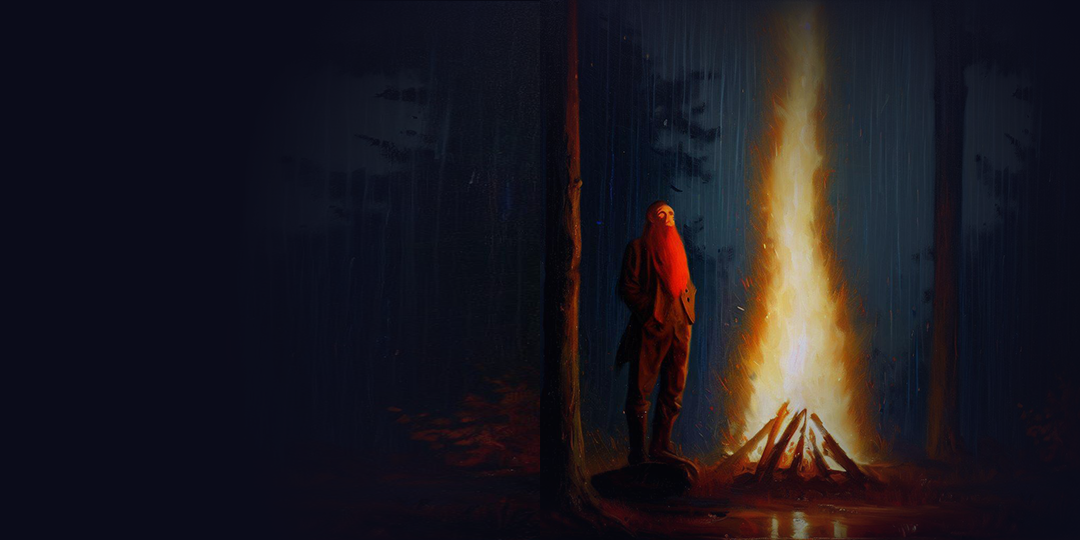
John Muir &
the Fire on the Mountain

On a stormy night in 1879, John Muir climbed the mountain behind Fort Wrangel and built a fire so large it lit up the sky. The reaction of the surprised Tlingit villagers below has gone down in legend, misunderstood and maligned for over a century. In today’s episode, we’ll look at the conflicts at play in John Muir‘s life to understand why he built the fire. We’ll dive into the people and places mentioned in the story, to better understand the Tlingit reaction.(Episode Transcript)
Check out John Muir’s Places to Visit Around Wrangell if you’re interested in checking out places mentioned in this episode!
John of the Mountains
John Muir (1838 - 1914) was a world-famous naturalist, who explored and documented America’s vast wilderness.
In 1879, at the age of 40, he traveled to Alaska, making Fort Wrangel is home away from home. This was a crossroads moment in John Muir’s life, where echoes of his past mingled with signs of the road that lay ahead.
He never wrote about the fire on the mountain until Travels in Alaska, published after his death.
John Muir was obsessed with studying the scientific theory that mountain ranges were carved in rock by ancient glaciers.
Alaska is home to many glaciers, providing Muir an opportunity study glaciers up close.
Rev. Sheldon Jackson appears in the middle, on board the voyage of the Bear in 1874.
Reverend Sheldon Jackson
One way John Muir supported himself was on the lecture circuit, getting paid to tell stories about his wilderness adventures to the public.
Another popular lecture speaker was the Reverend Sheldon Jackson, who told grand, embellished stories about his flagship mission to the Tlingit in Fort Wrangel, Alaska.
The two men met and struck up a relationship. Jackson invited Muir to join him on a steamship voyage to Alaska in June 1879. Muir accepted.
Reverend S. Hall Young
The only corroborating witness to the story of the fire on the mountain is the Reverend S. Hall Young. Young is mentioned in John Muir’s version of the story, and Young published his own version in Alaska Days with John Muir.
Customs Collector R.D. Crittenden
In 1879, the only man in Fort Wrangel with any government title at all was Rudolph D. Crittenden, the Deputy Collector of Customs.
According to Muir, Crittenden was the first person visited by the Tlingit men on the night of the fire.
This photo was taken around 1863, while Crittenden was a Confederate prisoner of war inside Fort Warren.
View From KaachXana.áakʼw
Long before there was Fort Wrangel, there was the Tlingit village of Kaach.xan.a’kw. During Muir’s time, this village numbered in the hundreds and stretched along miles of coastline, going out to Shustack’s Point.
This photo is from 1900, twenty years after the night of Muir’s fire on the mountain. From the village, you clearly had a clear view of the sky above Mount Dewey.
This point is often referred to Shustack’s Point, named for the Tlingit headman who lived out on this point.
On the night of John Muir’s fire, the light in the clouds likely reflected in the water of Etolin Harbor.
This photo is captioned "Indian funeral at Fort Wrangel.” It is estimated to be taken several years after John Muir’s visit. (source)
Alaska Evergreens
In the weeks after his bonfire on Mount Dewey, John Muir submitted a an article from Alaska on the trees to be found on Wrangell Island.
“A yellow cedar fire, to any one witnessing it for a time, is quite a notable phenomenon,” wrote Muir.
Clipping from The Daily Intelligencer, Volume VII, Number 141, 16 November 1879.
Journey to Chilkat Country
John Muir’s fire on the mountain happened before the legendary canoe voyage to Chilcat Country that would becoming his crowning achievement in Alaska.
In 1880, Muir returned to Fort Wrangel, to continue his canoe voyages in the company of his friend, the Reverend S. Hall Young.
Map from Alaska Days with John Muir by Reverend S. Hall Young.




